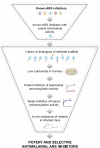Analogs of natural aminoacyl-tRNA synthetase inhibitors clear malaria in vivo
- PMID: 25489076
- PMCID: PMC4280603
- DOI: 10.1073/pnas.1405994111
Analogs of natural aminoacyl-tRNA synthetase inhibitors clear malaria in vivo
Abstract
Malaria remains a major global health problem. Emerging resistance to existing antimalarial drugs drives the search for new antimalarials, and protein translation is a promising pathway to target. Here we explore the potential of the aminoacyl-tRNA synthetase (ARS) family as a source of antimalarial drug targets. First, a battery of known and novel ARS inhibitors was tested against Plasmodium falciparum cultures, and their activities were compared. Borrelidin, a natural inhibitor of threonyl-tRNA synthetase (ThrRS), stands out for its potent antimalarial effect. However, it also inhibits human ThrRS and is highly toxic to human cells. To circumvent this problem, we tested a library of bioengineered and semisynthetic borrelidin analogs for their antimalarial activity and toxicity. We found that some analogs effectively lose their toxicity against human cells while retaining a potent antiparasitic activity both in vitro and in vivo and cleared malaria from Plasmodium yoelii-infected mice, resulting in 100% mice survival rates. Our work identifies borrelidin analogs as potent, selective, and unexplored scaffolds that efficiently clear malaria both in vitro and in vivo.
Keywords: aminoacyl-tRNA synthetase; borrelidin; drug design; malaria; plasmodium.
Conflict of interest statement
The authors declare no conflict of interest.
Figures





Similar articles
-
The growing pipeline of natural aminoacyl-tRNA synthetase inhibitors for malaria treatment.Bioengineered. 2016 Apr 2;7(2):60-4. doi: 10.1080/21655979.2016.1149270. Epub 2016 Mar 10. Bioengineered. 2016. PMID: 26963157 Free PMC article.
-
Selective inhibition of an apicoplastic aminoacyl-tRNA synthetase from Plasmodium falciparum.Chembiochem. 2013 Mar 4;14(4):499-509. doi: 10.1002/cbic.201200620. Chembiochem. 2013. PMID: 23444099
-
Structural analyses of the malaria parasite aminoacyl-tRNA synthetases provide new avenues for antimalarial drug discovery.Protein Sci. 2021 Sep;30(9):1793-1803. doi: 10.1002/pro.4148. Protein Sci. 2021. PMID: 34184352 Free PMC article. Review.
-
The cytoplasmic prolyl-tRNA synthetase of the malaria parasite is a dual-stage target of febrifugine and its analogs.Sci Transl Med. 2015 May 20;7(288):288ra77. doi: 10.1126/scitranslmed.aaa3575. Sci Transl Med. 2015. PMID: 25995223 Free PMC article.
-
Drug targeting of one or more aminoacyl-tRNA synthetase in the malaria parasite Plasmodium falciparum.Drug Discov Today. 2018 Jun;23(6):1233-1240. doi: 10.1016/j.drudis.2018.01.050. Epub 2018 Feb 8. Drug Discov Today. 2018. PMID: 29408369 Review.
Cited by
-
Progress and challenges in aminoacyl-tRNA synthetase-based therapeutics.J Biol Chem. 2019 Apr 5;294(14):5365-5385. doi: 10.1074/jbc.REV118.002956. Epub 2019 Jan 22. J Biol Chem. 2019. PMID: 30670594 Free PMC article. Review.
-
Borrelidin Induces the Unfolded Protein Response in Oral Cancer Cells and Chop-Dependent Apoptosis.ACS Med Chem Lett. 2015 Sep 8;6(11):1122-7. doi: 10.1021/acsmedchemlett.5b00133. eCollection 2015 Nov 12. ACS Med Chem Lett. 2015. PMID: 26617965 Free PMC article.
-
tRNA synthetase activity is required for stress granule and P-body assembly.bioRxiv [Preprint]. 2025 Mar 13:2025.03.10.642431. doi: 10.1101/2025.03.10.642431. bioRxiv. 2025. PMID: 40161773 Free PMC article. Preprint.
-
The PfAlba1 RNA-binding protein is an important regulator of translational timing in Plasmodium falciparum blood stages.Genome Biol. 2015 Sep 28;16:212. doi: 10.1186/s13059-015-0771-5. Genome Biol. 2015. PMID: 26415947 Free PMC article.
-
In silico assessment of natural products and approved drugs as potential inhibitory scaffolds targeting aminoacyl-tRNA synthetases from Plasmodium.3 Biotech. 2020 Nov;10(11):470. doi: 10.1007/s13205-020-02460-6. Epub 2020 Oct 12. 3 Biotech. 2020. PMID: 33088666 Free PMC article.
References
-
- Jomaa H, et al. Inhibitors of the nonmevalonate pathway of isoprenoid biosynthesis as antimalarial drugs. Science. 1999;285(5433):1573–1576. - PubMed
-
- Ralph SA, D’Ombrain MC, McFadden GI. The apicoplast as an antimalarial drug target. Drug Resist Updat. 2001;4(3):145–151. - PubMed
-
- Seeber F. Biosynthetic pathways of plastid-derived organelles as potential drug targets against parasitic apicomplexa. Curr Drug Targets Immune Endocr Metabol Disord. 2003;3(2):99–109. - PubMed
-
- Surolia N, Surolia A. Triclosan offers protection against blood stages of malaria by inhibiting enoyl-ACP reductase of Plasmodium falciparum. Nat Med. 2001;7(2):167–173. - PubMed
-
- Borrmann S, et al. Fosmidomycin-clindamycin for the treatment of Plasmodium falciparum malaria. J Infect Dis. 2004;190(9):1534–1540. - PubMed
Publication types
MeSH terms
Substances
Grants and funding
LinkOut - more resources
Full Text Sources
Other Literature Sources
Molecular Biology Databases

